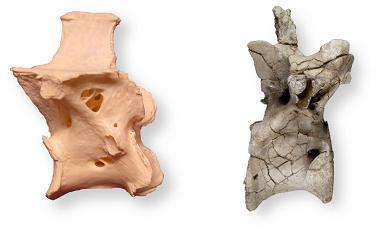It seems that the
pulmonary (of the lungs) systems of birds and dinosaurs may have been more similar than scientists previously thought:). According to new
research from
Ohio University and
Harvard University, published in this week's issue of the journal
Nature, the ancient beasts boasted a much bigger, more complex system of air sacs similar to that in today's birds. The finding is one of several studies in recent years to paint a new, more avian-like portrait of meat-eaters such as T. rex: The creatures may have had feathers, incubated their eggs, grown quickly and perhaps even breathed like birds:).

Bird and Dinosaur bones are similar (Courtesy: Ohio University)According to one of the authors (
Leon Claessens), the pulmonary system of meat-eating dinosaurs such as T. rex in fact shares many structural similarities with that of modern birds, which, from an engineering point of view, may possess the most efficient respiratory system of any living vertebrate inhabiting the land or sky.
The authors visited museums in New York, Berkeley, Chicago, Pittsburgh, Washington, D.C., Berlin and London to examine the bones of ancient beasts, and also studied a 67 million year old dinosaur,
Majungatholus Atopus. They compared the dinosaur skeletons with those of modern birds to draw comparisons of how the soft tissues in the dinosaurs may have been structured.
The scientists are part of a reinvigorated movement of researchers who are examining dinosaur bones and comparing them with modern animals to learn more about the anatomy of these extinct beasts.